University Report: Circular Economy for Sustainable Urban Development
VerifiedAdded on 2022/09/18
|11
|2927
|21
Report
AI Summary
This report delves into the concept of the circular economy, emphasizing its significance in urban environments. It explores the core principles of reduce, reuse, and recycle, highlighting how cities, which contribute significantly to global GDP and resource consumption, can adopt circular economy models to reduce waste, conserve resources, and lower greenhouse gas emissions. The report discusses the role of cities in driving the global transition towards a circular economy, addressing challenges such as the 'take-make-dispose' business model and advocating for strategies that promote resource efficiency and environmental sustainability. It examines the benefits of circular economy, including cost reduction, enhanced corporate social responsibility, and improved environmental conditions. The analysis includes references to key literature and discusses the importance of consensus and local practices in implementing circular economy initiatives, concluding with the potential for economic and environmental improvements through the adoption of circular economy principles in urban settings.
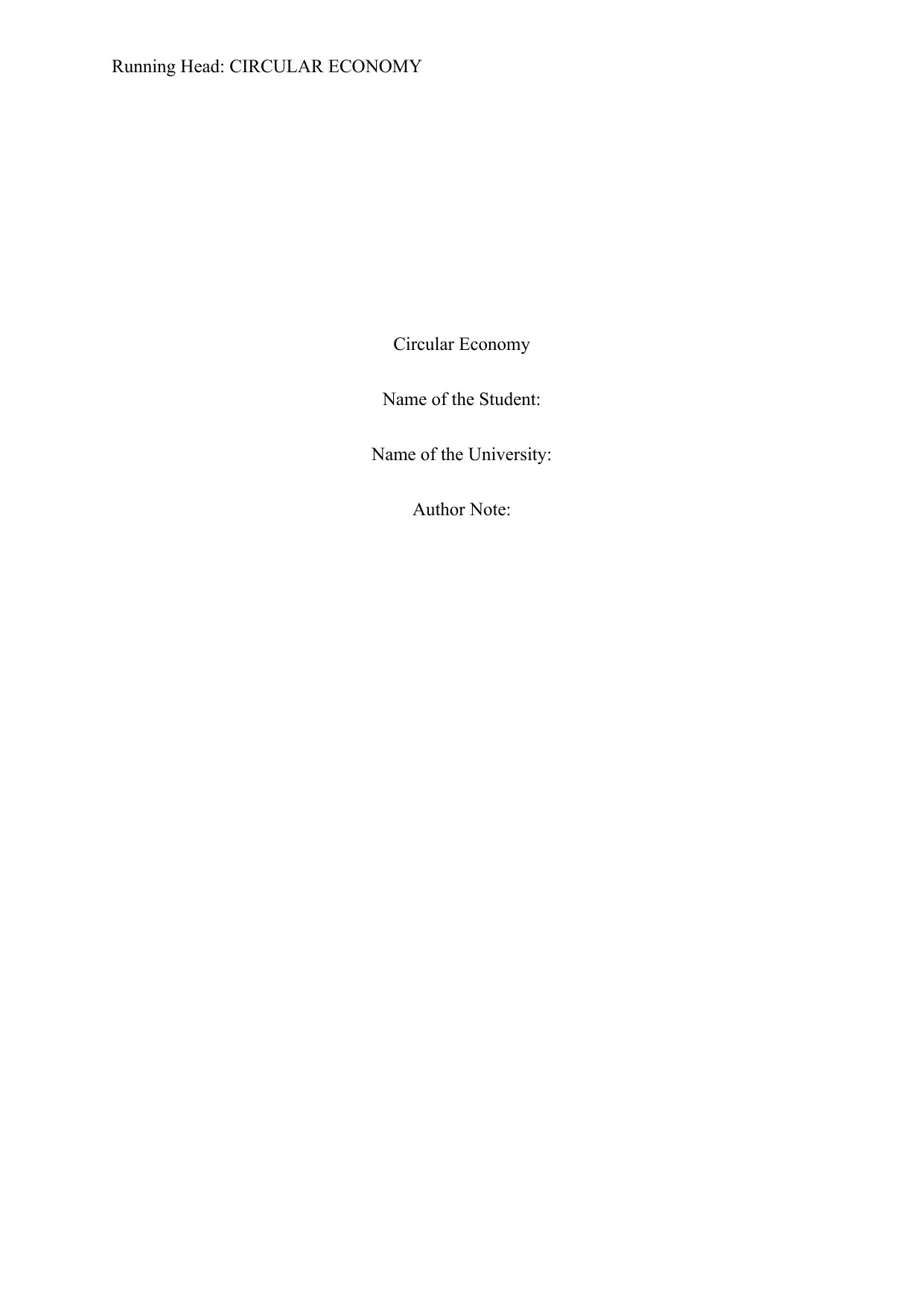
Running Head: CIRCULAR ECONOMY
Circular Economy
Name of the Student:
Name of the University:
Author Note:
Circular Economy
Name of the Student:
Name of the University:
Author Note:
Paraphrase This Document
Need a fresh take? Get an instant paraphrase of this document with our AI Paraphraser

1CIRCULAR ECONOMY
Circular Economy
Circular economy is considered to be the closed loop in which raw materials as well
as products and components moved in a circular motion with the hope of reuse the same
material and components to reduce the cost of production (Kirchherr, Reike and Hekkert
2017). As per my opinion this increase the profit earning of the organization and help them to
produce the same volume of products by investing less cost in the process. This is also
essential for the organization as per my observation to enhance the corporate social
responsibility that will automatically enrich the image of the firm in the marketplace
(Geissdoerfer et al. 2017).
I have also noticed that there are three elements in which circular economy is
revolving and the components are: Reduce, Reuse and Recycle. If the organization follows
this economy in their business model then they will not only reduce the cost of production but
will also benefit the society and the environment (Korhonen, Honkasalo and Seppälä 2018).
As per my opinion, this is crucial for the expansion of the firm in the marketplace and also to
enrich the image in the society and become popular among the consumers in the marketplace.
Therefore, this is critical as well as necessary for the organization if it is willing to achieve
the target and to become popular in the marketplace (Zink and Geyer 2017).
Role of Cities in Circular Economy
As per Macarthur (2017), it has been observed by me through his writing is that cities
play a major role in the growth of the global circular economy. It has been noted that 54% of
the total pollution of the world lives in urban region and the cities mainly contributes to the
85% of the world GDP. Therefore, the cities accounts for the 75% of the consumption of the
natural resources along with that 60% - 80% of the emission of the greenhouse gas and 50%
of the production of the global wastes. Therefore, it is essential for the companies to
Circular Economy
Circular economy is considered to be the closed loop in which raw materials as well
as products and components moved in a circular motion with the hope of reuse the same
material and components to reduce the cost of production (Kirchherr, Reike and Hekkert
2017). As per my opinion this increase the profit earning of the organization and help them to
produce the same volume of products by investing less cost in the process. This is also
essential for the organization as per my observation to enhance the corporate social
responsibility that will automatically enrich the image of the firm in the marketplace
(Geissdoerfer et al. 2017).
I have also noticed that there are three elements in which circular economy is
revolving and the components are: Reduce, Reuse and Recycle. If the organization follows
this economy in their business model then they will not only reduce the cost of production but
will also benefit the society and the environment (Korhonen, Honkasalo and Seppälä 2018).
As per my opinion, this is crucial for the expansion of the firm in the marketplace and also to
enrich the image in the society and become popular among the consumers in the marketplace.
Therefore, this is critical as well as necessary for the organization if it is willing to achieve
the target and to become popular in the marketplace (Zink and Geyer 2017).
Role of Cities in Circular Economy
As per Macarthur (2017), it has been observed by me through his writing is that cities
play a major role in the growth of the global circular economy. It has been noted that 54% of
the total pollution of the world lives in urban region and the cities mainly contributes to the
85% of the world GDP. Therefore, the cities accounts for the 75% of the consumption of the
natural resources along with that 60% - 80% of the emission of the greenhouse gas and 50%
of the production of the global wastes. Therefore, it is essential for the companies to
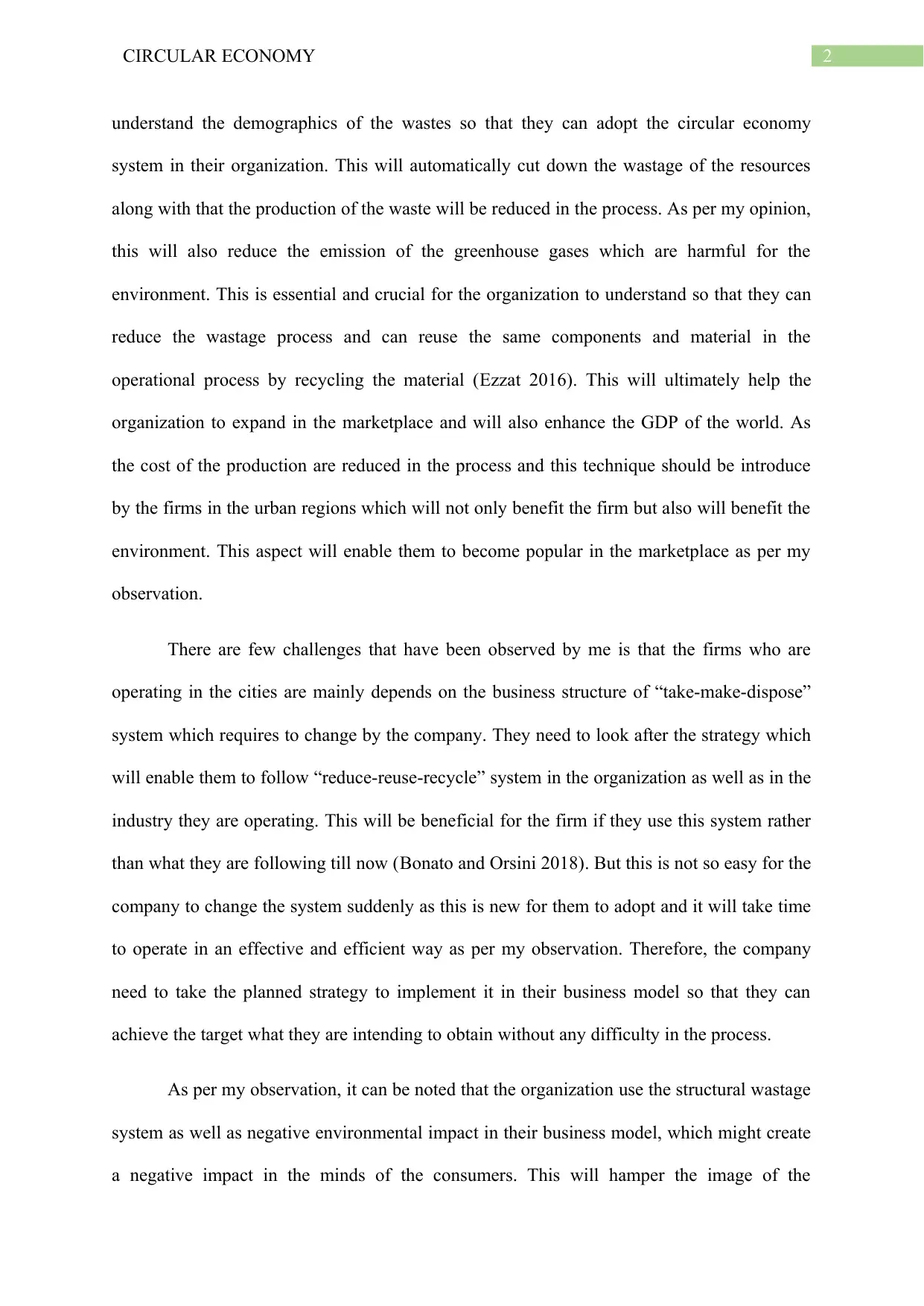
2CIRCULAR ECONOMY
understand the demographics of the wastes so that they can adopt the circular economy
system in their organization. This will automatically cut down the wastage of the resources
along with that the production of the waste will be reduced in the process. As per my opinion,
this will also reduce the emission of the greenhouse gases which are harmful for the
environment. This is essential and crucial for the organization to understand so that they can
reduce the wastage process and can reuse the same components and material in the
operational process by recycling the material (Ezzat 2016). This will ultimately help the
organization to expand in the marketplace and will also enhance the GDP of the world. As
the cost of the production are reduced in the process and this technique should be introduce
by the firms in the urban regions which will not only benefit the firm but also will benefit the
environment. This aspect will enable them to become popular in the marketplace as per my
observation.
There are few challenges that have been observed by me is that the firms who are
operating in the cities are mainly depends on the business structure of “take-make-dispose”
system which requires to change by the company. They need to look after the strategy which
will enable them to follow “reduce-reuse-recycle” system in the organization as well as in the
industry they are operating. This will be beneficial for the firm if they use this system rather
than what they are following till now (Bonato and Orsini 2018). But this is not so easy for the
company to change the system suddenly as this is new for them to adopt and it will take time
to operate in an effective and efficient way as per my observation. Therefore, the company
need to take the planned strategy to implement it in their business model so that they can
achieve the target what they are intending to obtain without any difficulty in the process.
As per my observation, it can be noted that the organization use the structural wastage
system as well as negative environmental impact in their business model, which might create
a negative impact in the minds of the consumers. This will hamper the image of the
understand the demographics of the wastes so that they can adopt the circular economy
system in their organization. This will automatically cut down the wastage of the resources
along with that the production of the waste will be reduced in the process. As per my opinion,
this will also reduce the emission of the greenhouse gases which are harmful for the
environment. This is essential and crucial for the organization to understand so that they can
reduce the wastage process and can reuse the same components and material in the
operational process by recycling the material (Ezzat 2016). This will ultimately help the
organization to expand in the marketplace and will also enhance the GDP of the world. As
the cost of the production are reduced in the process and this technique should be introduce
by the firms in the urban regions which will not only benefit the firm but also will benefit the
environment. This aspect will enable them to become popular in the marketplace as per my
observation.
There are few challenges that have been observed by me is that the firms who are
operating in the cities are mainly depends on the business structure of “take-make-dispose”
system which requires to change by the company. They need to look after the strategy which
will enable them to follow “reduce-reuse-recycle” system in the organization as well as in the
industry they are operating. This will be beneficial for the firm if they use this system rather
than what they are following till now (Bonato and Orsini 2018). But this is not so easy for the
company to change the system suddenly as this is new for them to adopt and it will take time
to operate in an effective and efficient way as per my observation. Therefore, the company
need to take the planned strategy to implement it in their business model so that they can
achieve the target what they are intending to obtain without any difficulty in the process.
As per my observation, it can be noted that the organization use the structural wastage
system as well as negative environmental impact in their business model, which might create
a negative impact in the minds of the consumers. This will hamper the image of the
⊘ This is a preview!⊘
Do you want full access?
Subscribe today to unlock all pages.

Trusted by 1+ million students worldwide
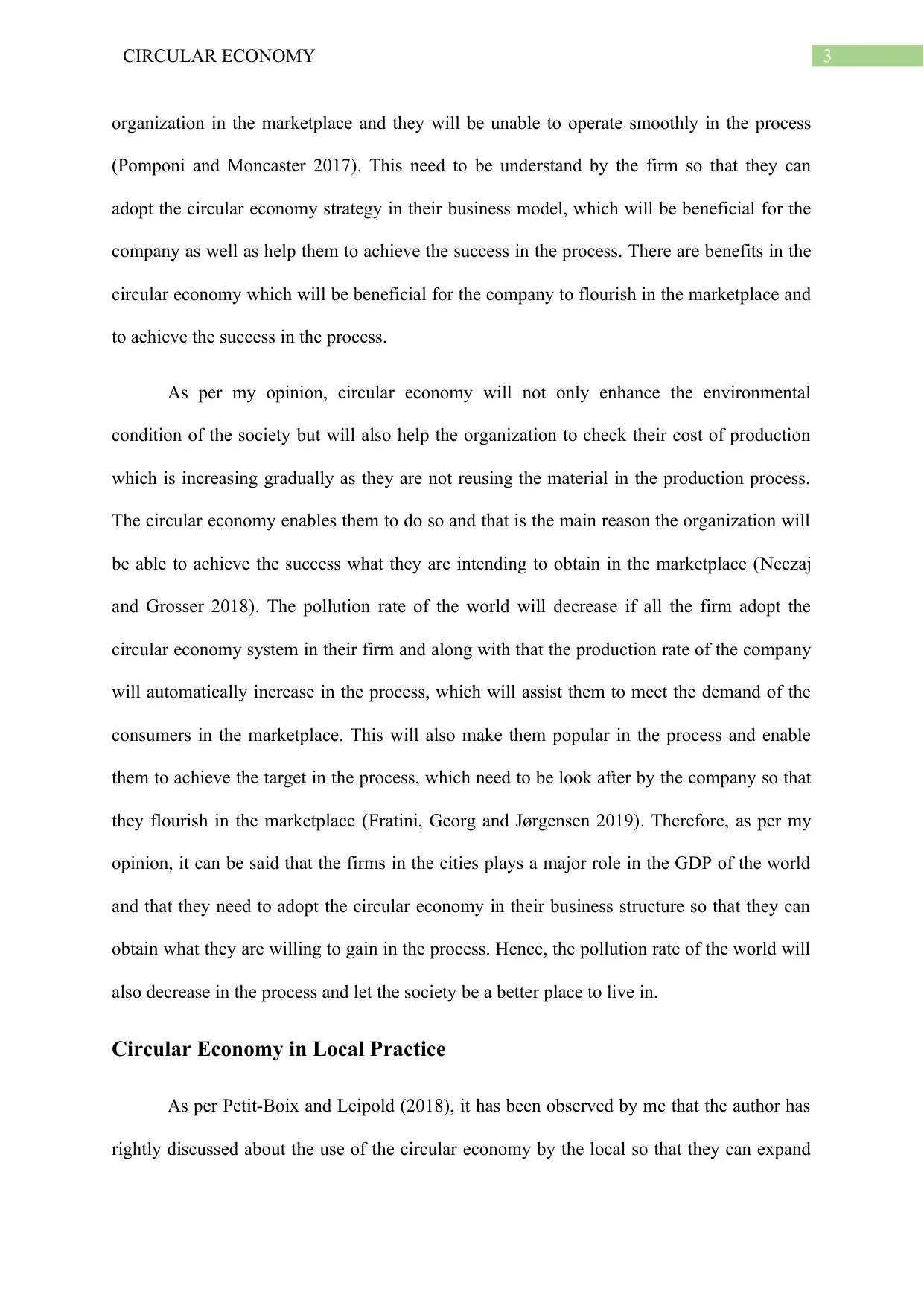
3CIRCULAR ECONOMY
organization in the marketplace and they will be unable to operate smoothly in the process
(Pomponi and Moncaster 2017). This need to be understand by the firm so that they can
adopt the circular economy strategy in their business model, which will be beneficial for the
company as well as help them to achieve the success in the process. There are benefits in the
circular economy which will be beneficial for the company to flourish in the marketplace and
to achieve the success in the process.
As per my opinion, circular economy will not only enhance the environmental
condition of the society but will also help the organization to check their cost of production
which is increasing gradually as they are not reusing the material in the production process.
The circular economy enables them to do so and that is the main reason the organization will
be able to achieve the success what they are intending to obtain in the marketplace (Neczaj
and Grosser 2018). The pollution rate of the world will decrease if all the firm adopt the
circular economy system in their firm and along with that the production rate of the company
will automatically increase in the process, which will assist them to meet the demand of the
consumers in the marketplace. This will also make them popular in the process and enable
them to achieve the target in the process, which need to be look after by the company so that
they flourish in the marketplace (Fratini, Georg and Jørgensen 2019). Therefore, as per my
opinion, it can be said that the firms in the cities plays a major role in the GDP of the world
and that they need to adopt the circular economy in their business structure so that they can
obtain what they are willing to gain in the process. Hence, the pollution rate of the world will
also decrease in the process and let the society be a better place to live in.
Circular Economy in Local Practice
As per Petit-Boix and Leipold (2018), it has been observed by me that the author has
rightly discussed about the use of the circular economy by the local so that they can expand
organization in the marketplace and they will be unable to operate smoothly in the process
(Pomponi and Moncaster 2017). This need to be understand by the firm so that they can
adopt the circular economy strategy in their business model, which will be beneficial for the
company as well as help them to achieve the success in the process. There are benefits in the
circular economy which will be beneficial for the company to flourish in the marketplace and
to achieve the success in the process.
As per my opinion, circular economy will not only enhance the environmental
condition of the society but will also help the organization to check their cost of production
which is increasing gradually as they are not reusing the material in the production process.
The circular economy enables them to do so and that is the main reason the organization will
be able to achieve the success what they are intending to obtain in the marketplace (Neczaj
and Grosser 2018). The pollution rate of the world will decrease if all the firm adopt the
circular economy system in their firm and along with that the production rate of the company
will automatically increase in the process, which will assist them to meet the demand of the
consumers in the marketplace. This will also make them popular in the process and enable
them to achieve the target in the process, which need to be look after by the company so that
they flourish in the marketplace (Fratini, Georg and Jørgensen 2019). Therefore, as per my
opinion, it can be said that the firms in the cities plays a major role in the GDP of the world
and that they need to adopt the circular economy in their business structure so that they can
obtain what they are willing to gain in the process. Hence, the pollution rate of the world will
also decrease in the process and let the society be a better place to live in.
Circular Economy in Local Practice
As per Petit-Boix and Leipold (2018), it has been observed by me that the author has
rightly discussed about the use of the circular economy by the local so that they can expand
Paraphrase This Document
Need a fresh take? Get an instant paraphrase of this document with our AI Paraphraser
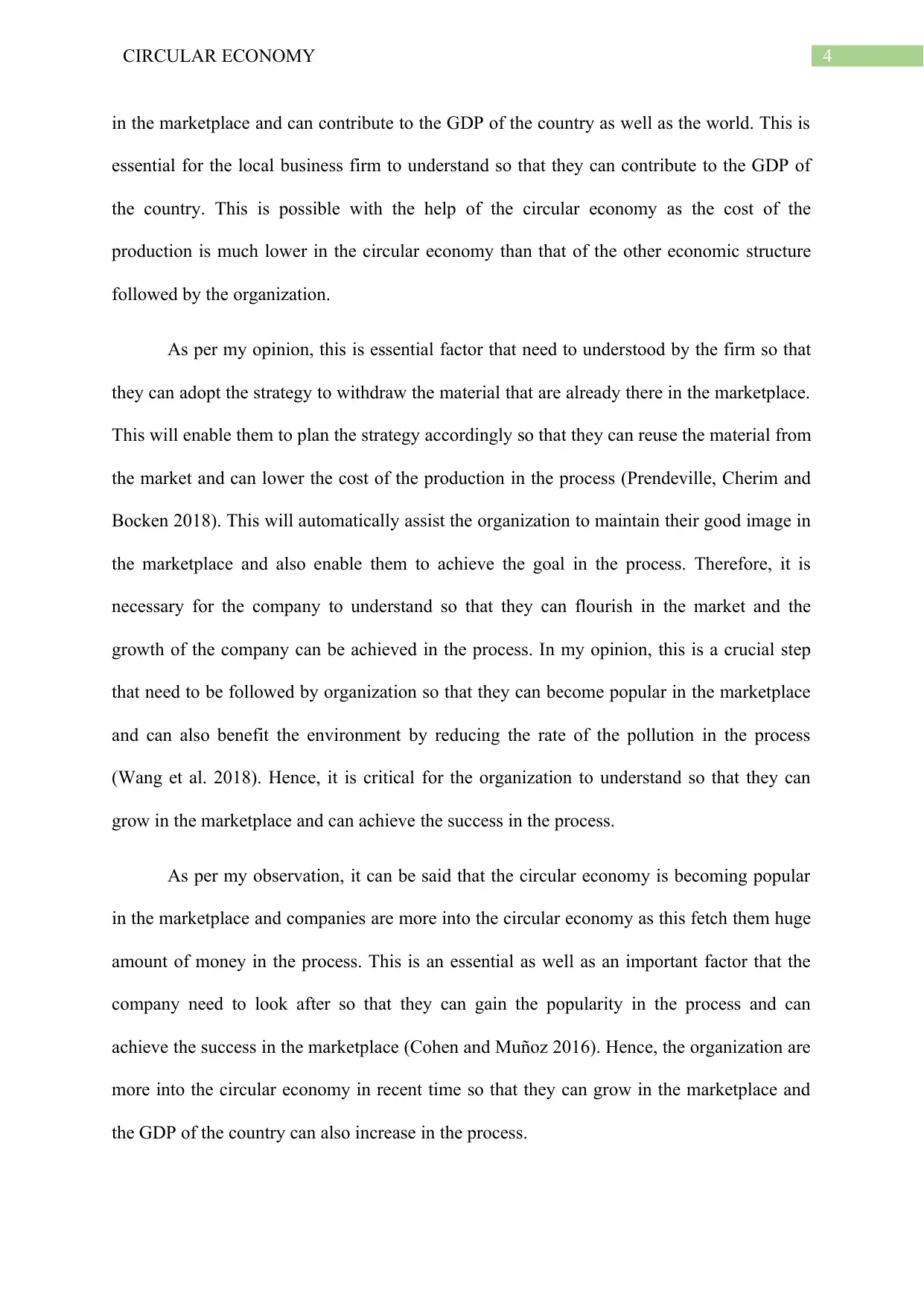
4CIRCULAR ECONOMY
in the marketplace and can contribute to the GDP of the country as well as the world. This is
essential for the local business firm to understand so that they can contribute to the GDP of
the country. This is possible with the help of the circular economy as the cost of the
production is much lower in the circular economy than that of the other economic structure
followed by the organization.
As per my opinion, this is essential factor that need to understood by the firm so that
they can adopt the strategy to withdraw the material that are already there in the marketplace.
This will enable them to plan the strategy accordingly so that they can reuse the material from
the market and can lower the cost of the production in the process (Prendeville, Cherim and
Bocken 2018). This will automatically assist the organization to maintain their good image in
the marketplace and also enable them to achieve the goal in the process. Therefore, it is
necessary for the company to understand so that they can flourish in the market and the
growth of the company can be achieved in the process. In my opinion, this is a crucial step
that need to be followed by organization so that they can become popular in the marketplace
and can also benefit the environment by reducing the rate of the pollution in the process
(Wang et al. 2018). Hence, it is critical for the organization to understand so that they can
grow in the marketplace and can achieve the success in the process.
As per my observation, it can be said that the circular economy is becoming popular
in the marketplace and companies are more into the circular economy as this fetch them huge
amount of money in the process. This is an essential as well as an important factor that the
company need to look after so that they can gain the popularity in the process and can
achieve the success in the marketplace (Cohen and Muñoz 2016). Hence, the organization are
more into the circular economy in recent time so that they can grow in the marketplace and
the GDP of the country can also increase in the process.
in the marketplace and can contribute to the GDP of the country as well as the world. This is
essential for the local business firm to understand so that they can contribute to the GDP of
the country. This is possible with the help of the circular economy as the cost of the
production is much lower in the circular economy than that of the other economic structure
followed by the organization.
As per my opinion, this is essential factor that need to understood by the firm so that
they can adopt the strategy to withdraw the material that are already there in the marketplace.
This will enable them to plan the strategy accordingly so that they can reuse the material from
the market and can lower the cost of the production in the process (Prendeville, Cherim and
Bocken 2018). This will automatically assist the organization to maintain their good image in
the marketplace and also enable them to achieve the goal in the process. Therefore, it is
necessary for the company to understand so that they can flourish in the market and the
growth of the company can be achieved in the process. In my opinion, this is a crucial step
that need to be followed by organization so that they can become popular in the marketplace
and can also benefit the environment by reducing the rate of the pollution in the process
(Wang et al. 2018). Hence, it is critical for the organization to understand so that they can
grow in the marketplace and can achieve the success in the process.
As per my observation, it can be said that the circular economy is becoming popular
in the marketplace and companies are more into the circular economy as this fetch them huge
amount of money in the process. This is an essential as well as an important factor that the
company need to look after so that they can gain the popularity in the process and can
achieve the success in the marketplace (Cohen and Muñoz 2016). Hence, the organization are
more into the circular economy in recent time so that they can grow in the marketplace and
the GDP of the country can also increase in the process.
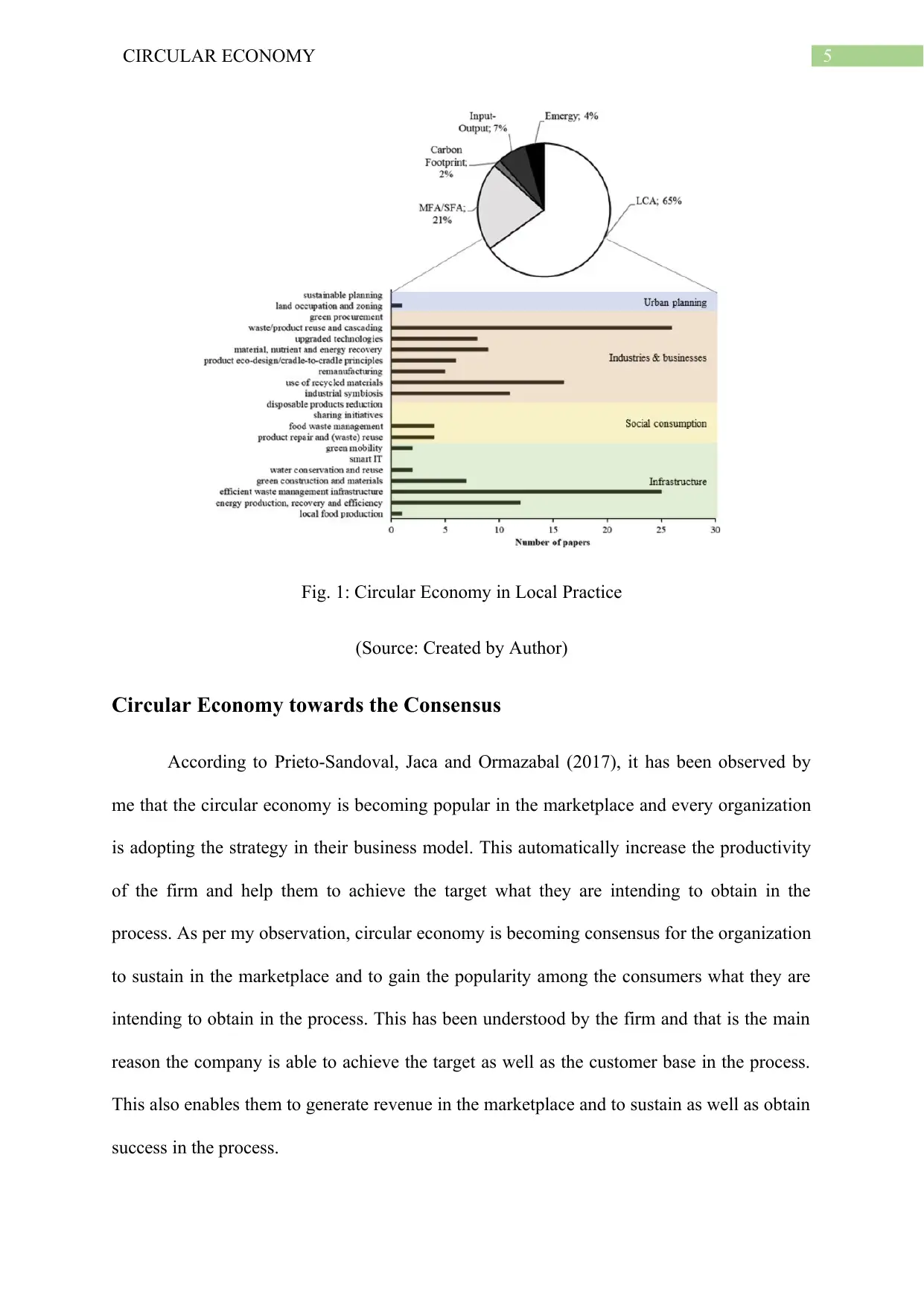
5CIRCULAR ECONOMY
Fig. 1: Circular Economy in Local Practice
(Source: Created by Author)
Circular Economy towards the Consensus
According to Prieto-Sandoval, Jaca and Ormazabal (2017), it has been observed by
me that the circular economy is becoming popular in the marketplace and every organization
is adopting the strategy in their business model. This automatically increase the productivity
of the firm and help them to achieve the target what they are intending to obtain in the
process. As per my observation, circular economy is becoming consensus for the organization
to sustain in the marketplace and to gain the popularity among the consumers what they are
intending to obtain in the process. This has been understood by the firm and that is the main
reason the company is able to achieve the target as well as the customer base in the process.
This also enables them to generate revenue in the marketplace and to sustain as well as obtain
success in the process.
Fig. 1: Circular Economy in Local Practice
(Source: Created by Author)
Circular Economy towards the Consensus
According to Prieto-Sandoval, Jaca and Ormazabal (2017), it has been observed by
me that the circular economy is becoming popular in the marketplace and every organization
is adopting the strategy in their business model. This automatically increase the productivity
of the firm and help them to achieve the target what they are intending to obtain in the
process. As per my observation, circular economy is becoming consensus for the organization
to sustain in the marketplace and to gain the popularity among the consumers what they are
intending to obtain in the process. This has been understood by the firm and that is the main
reason the company is able to achieve the target as well as the customer base in the process.
This also enables them to generate revenue in the marketplace and to sustain as well as obtain
success in the process.
⊘ This is a preview!⊘
Do you want full access?
Subscribe today to unlock all pages.

Trusted by 1+ million students worldwide
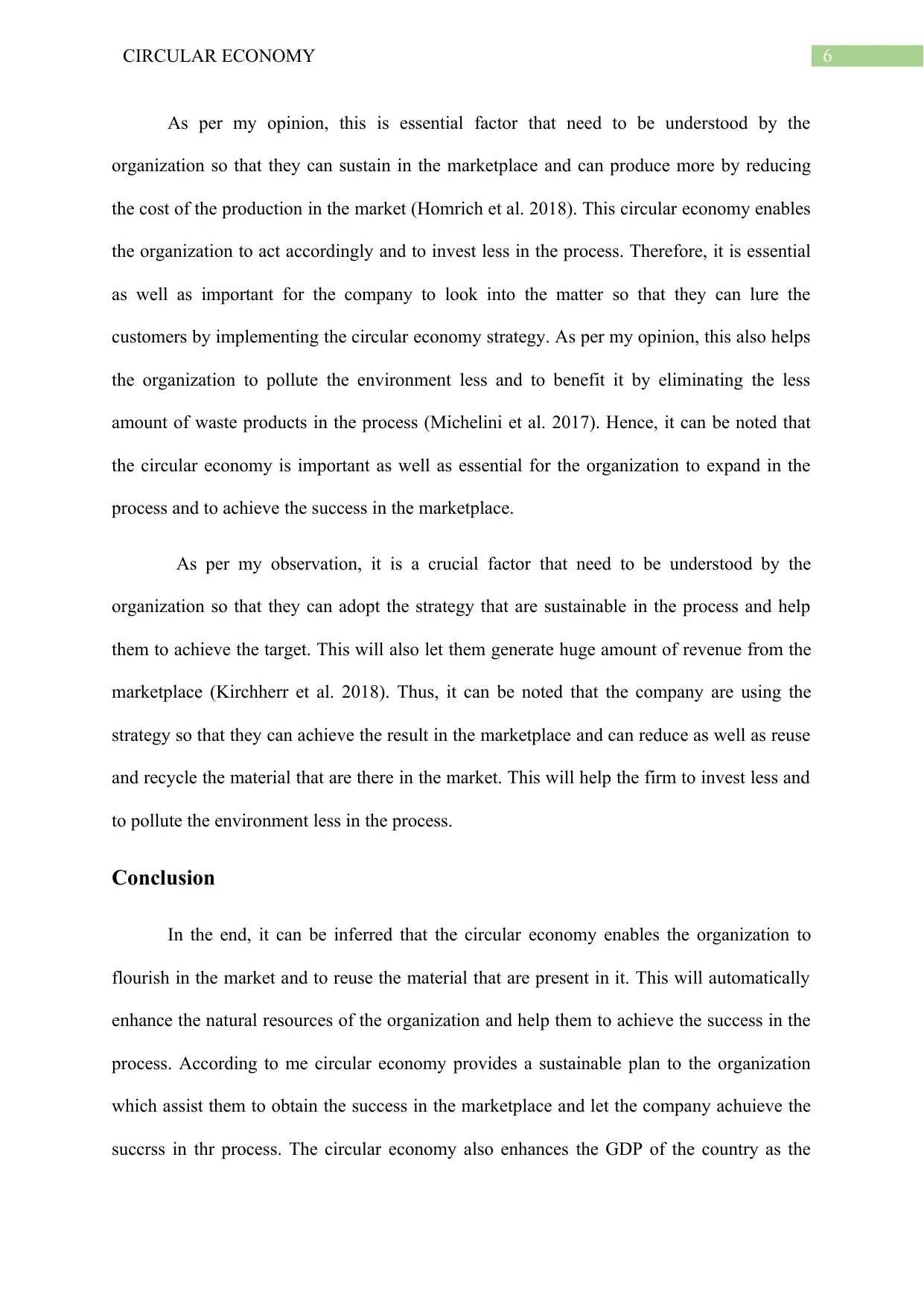
6CIRCULAR ECONOMY
As per my opinion, this is essential factor that need to be understood by the
organization so that they can sustain in the marketplace and can produce more by reducing
the cost of the production in the market (Homrich et al. 2018). This circular economy enables
the organization to act accordingly and to invest less in the process. Therefore, it is essential
as well as important for the company to look into the matter so that they can lure the
customers by implementing the circular economy strategy. As per my opinion, this also helps
the organization to pollute the environment less and to benefit it by eliminating the less
amount of waste products in the process (Michelini et al. 2017). Hence, it can be noted that
the circular economy is important as well as essential for the organization to expand in the
process and to achieve the success in the marketplace.
As per my observation, it is a crucial factor that need to be understood by the
organization so that they can adopt the strategy that are sustainable in the process and help
them to achieve the target. This will also let them generate huge amount of revenue from the
marketplace (Kirchherr et al. 2018). Thus, it can be noted that the company are using the
strategy so that they can achieve the result in the marketplace and can reduce as well as reuse
and recycle the material that are there in the market. This will help the firm to invest less and
to pollute the environment less in the process.
Conclusion
In the end, it can be inferred that the circular economy enables the organization to
flourish in the market and to reuse the material that are present in it. This will automatically
enhance the natural resources of the organization and help them to achieve the success in the
process. According to me circular economy provides a sustainable plan to the organization
which assist them to obtain the success in the marketplace and let the company achuieve the
succrss in thr process. The circular economy also enhances the GDP of the country as the
As per my opinion, this is essential factor that need to be understood by the
organization so that they can sustain in the marketplace and can produce more by reducing
the cost of the production in the market (Homrich et al. 2018). This circular economy enables
the organization to act accordingly and to invest less in the process. Therefore, it is essential
as well as important for the company to look into the matter so that they can lure the
customers by implementing the circular economy strategy. As per my opinion, this also helps
the organization to pollute the environment less and to benefit it by eliminating the less
amount of waste products in the process (Michelini et al. 2017). Hence, it can be noted that
the circular economy is important as well as essential for the organization to expand in the
process and to achieve the success in the marketplace.
As per my observation, it is a crucial factor that need to be understood by the
organization so that they can adopt the strategy that are sustainable in the process and help
them to achieve the target. This will also let them generate huge amount of revenue from the
marketplace (Kirchherr et al. 2018). Thus, it can be noted that the company are using the
strategy so that they can achieve the result in the marketplace and can reduce as well as reuse
and recycle the material that are there in the market. This will help the firm to invest less and
to pollute the environment less in the process.
Conclusion
In the end, it can be inferred that the circular economy enables the organization to
flourish in the market and to reuse the material that are present in it. This will automatically
enhance the natural resources of the organization and help them to achieve the success in the
process. According to me circular economy provides a sustainable plan to the organization
which assist them to obtain the success in the marketplace and let the company achuieve the
succrss in thr process. The circular economy also enhances the GDP of the country as the
Paraphrase This Document
Need a fresh take? Get an instant paraphrase of this document with our AI Paraphraser
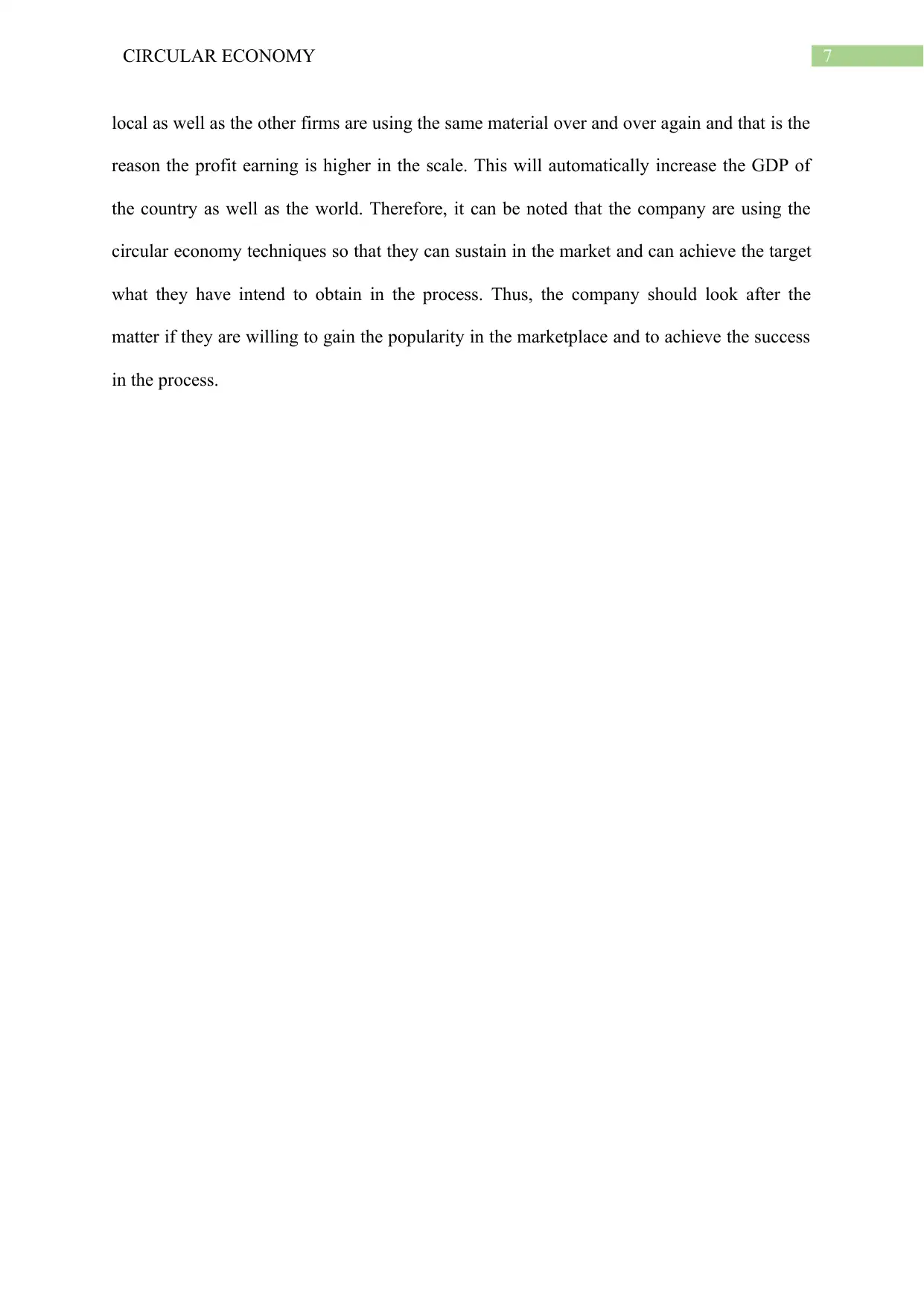
7CIRCULAR ECONOMY
local as well as the other firms are using the same material over and over again and that is the
reason the profit earning is higher in the scale. This will automatically increase the GDP of
the country as well as the world. Therefore, it can be noted that the company are using the
circular economy techniques so that they can sustain in the market and can achieve the target
what they have intend to obtain in the process. Thus, the company should look after the
matter if they are willing to gain the popularity in the marketplace and to achieve the success
in the process.
local as well as the other firms are using the same material over and over again and that is the
reason the profit earning is higher in the scale. This will automatically increase the GDP of
the country as well as the world. Therefore, it can be noted that the company are using the
circular economy techniques so that they can sustain in the market and can achieve the target
what they have intend to obtain in the process. Thus, the company should look after the
matter if they are willing to gain the popularity in the marketplace and to achieve the success
in the process.
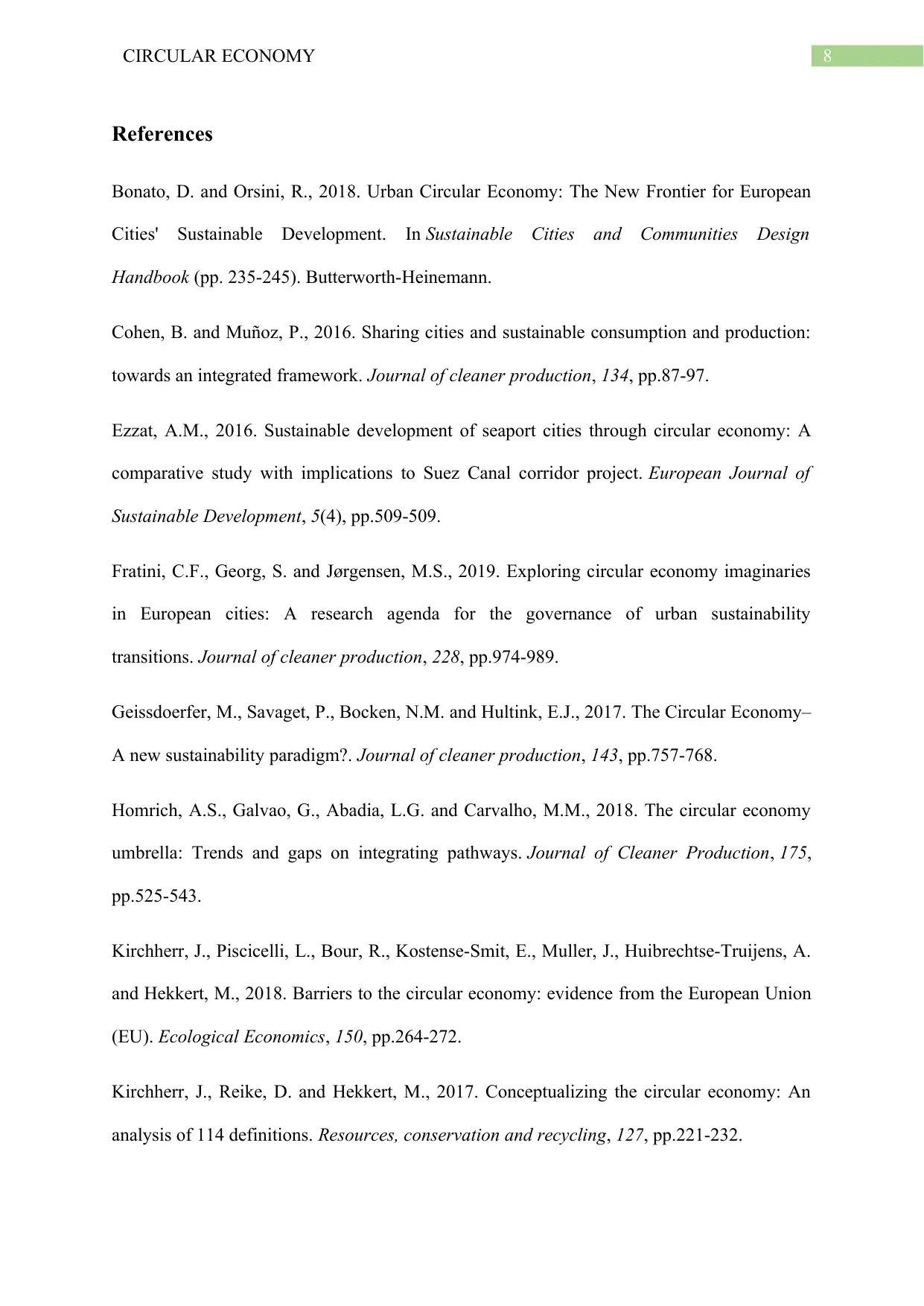
8CIRCULAR ECONOMY
References
Bonato, D. and Orsini, R., 2018. Urban Circular Economy: The New Frontier for European
Cities' Sustainable Development. In Sustainable Cities and Communities Design
Handbook (pp. 235-245). Butterworth-Heinemann.
Cohen, B. and Muñoz, P., 2016. Sharing cities and sustainable consumption and production:
towards an integrated framework. Journal of cleaner production, 134, pp.87-97.
Ezzat, A.M., 2016. Sustainable development of seaport cities through circular economy: A
comparative study with implications to Suez Canal corridor project. European Journal of
Sustainable Development, 5(4), pp.509-509.
Fratini, C.F., Georg, S. and Jørgensen, M.S., 2019. Exploring circular economy imaginaries
in European cities: A research agenda for the governance of urban sustainability
transitions. Journal of cleaner production, 228, pp.974-989.
Geissdoerfer, M., Savaget, P., Bocken, N.M. and Hultink, E.J., 2017. The Circular Economy–
A new sustainability paradigm?. Journal of cleaner production, 143, pp.757-768.
Homrich, A.S., Galvao, G., Abadia, L.G. and Carvalho, M.M., 2018. The circular economy
umbrella: Trends and gaps on integrating pathways. Journal of Cleaner Production, 175,
pp.525-543.
Kirchherr, J., Piscicelli, L., Bour, R., Kostense-Smit, E., Muller, J., Huibrechtse-Truijens, A.
and Hekkert, M., 2018. Barriers to the circular economy: evidence from the European Union
(EU). Ecological Economics, 150, pp.264-272.
Kirchherr, J., Reike, D. and Hekkert, M., 2017. Conceptualizing the circular economy: An
analysis of 114 definitions. Resources, conservation and recycling, 127, pp.221-232.
References
Bonato, D. and Orsini, R., 2018. Urban Circular Economy: The New Frontier for European
Cities' Sustainable Development. In Sustainable Cities and Communities Design
Handbook (pp. 235-245). Butterworth-Heinemann.
Cohen, B. and Muñoz, P., 2016. Sharing cities and sustainable consumption and production:
towards an integrated framework. Journal of cleaner production, 134, pp.87-97.
Ezzat, A.M., 2016. Sustainable development of seaport cities through circular economy: A
comparative study with implications to Suez Canal corridor project. European Journal of
Sustainable Development, 5(4), pp.509-509.
Fratini, C.F., Georg, S. and Jørgensen, M.S., 2019. Exploring circular economy imaginaries
in European cities: A research agenda for the governance of urban sustainability
transitions. Journal of cleaner production, 228, pp.974-989.
Geissdoerfer, M., Savaget, P., Bocken, N.M. and Hultink, E.J., 2017. The Circular Economy–
A new sustainability paradigm?. Journal of cleaner production, 143, pp.757-768.
Homrich, A.S., Galvao, G., Abadia, L.G. and Carvalho, M.M., 2018. The circular economy
umbrella: Trends and gaps on integrating pathways. Journal of Cleaner Production, 175,
pp.525-543.
Kirchherr, J., Piscicelli, L., Bour, R., Kostense-Smit, E., Muller, J., Huibrechtse-Truijens, A.
and Hekkert, M., 2018. Barriers to the circular economy: evidence from the European Union
(EU). Ecological Economics, 150, pp.264-272.
Kirchherr, J., Reike, D. and Hekkert, M., 2017. Conceptualizing the circular economy: An
analysis of 114 definitions. Resources, conservation and recycling, 127, pp.221-232.
⊘ This is a preview!⊘
Do you want full access?
Subscribe today to unlock all pages.

Trusted by 1+ million students worldwide

9CIRCULAR ECONOMY
Korhonen, J., Honkasalo, A. and Seppälä, J., 2018. Circular economy: the concept and its
limitations. Ecological economics, 143, pp.37-46.
Macarthur, E., 2017. CITIES IN THE CIRCULAR ECONOMY: AN INITIAL
EXPLORATION.
Michelini, G., Moraes, R.N., Cunha, R.N., Costa, J.M. and Ometto, A.R., 2017. From linear
to circular economy: PSS conducting the transition. Procedia CIRP, 64(1), pp.2-6.
Neczaj, E. and Grosser, A., 2018. Circular economy in wastewater treatment plant–
challenges and barriers. In Multidisciplinary Digital Publishing Institute Proceedings (Vol. 2,
No. 11, p. 614).
Petit-Boix, A. and Leipold, S., 2018. Circular Economy In Cities: Reviewing How
Environmental Research Aligns With Local Practices. [online] Elsevier. Available at:
<https://doi.org/10.1016/j.jclepro.2018.05.281> [Accessed 16 April 2020].
Pomponi, F. and Moncaster, A., 2017. Circular economy for the built environment: A
research framework. Journal of cleaner production, 143, pp.710-718.
Prendeville, S., Cherim, E. and Bocken, N., 2018. Circular cities: mapping six cities in
transition. Environmental innovation and societal transitions, 26, pp.171-194.
Prieto-Sandoval, V., Jaca, C. and Ormazabal, M., 2017. Towards A Consensus On The
Circular Economy. [online] Elsevier. Available at:
<https://doi.org/10.1016/j.jclepro.2017.12.224> [Accessed 16 April 2020].
Wang, N., Lee, J.C.K., Zhang, J., Chen, H. and Li, H., 2018. Evaluation of Urban circular
economy development: An empirical research of 40 cities in China. Journal of Cleaner
Production, 180, pp.876-887.
Korhonen, J., Honkasalo, A. and Seppälä, J., 2018. Circular economy: the concept and its
limitations. Ecological economics, 143, pp.37-46.
Macarthur, E., 2017. CITIES IN THE CIRCULAR ECONOMY: AN INITIAL
EXPLORATION.
Michelini, G., Moraes, R.N., Cunha, R.N., Costa, J.M. and Ometto, A.R., 2017. From linear
to circular economy: PSS conducting the transition. Procedia CIRP, 64(1), pp.2-6.
Neczaj, E. and Grosser, A., 2018. Circular economy in wastewater treatment plant–
challenges and barriers. In Multidisciplinary Digital Publishing Institute Proceedings (Vol. 2,
No. 11, p. 614).
Petit-Boix, A. and Leipold, S., 2018. Circular Economy In Cities: Reviewing How
Environmental Research Aligns With Local Practices. [online] Elsevier. Available at:
<https://doi.org/10.1016/j.jclepro.2018.05.281> [Accessed 16 April 2020].
Pomponi, F. and Moncaster, A., 2017. Circular economy for the built environment: A
research framework. Journal of cleaner production, 143, pp.710-718.
Prendeville, S., Cherim, E. and Bocken, N., 2018. Circular cities: mapping six cities in
transition. Environmental innovation and societal transitions, 26, pp.171-194.
Prieto-Sandoval, V., Jaca, C. and Ormazabal, M., 2017. Towards A Consensus On The
Circular Economy. [online] Elsevier. Available at:
<https://doi.org/10.1016/j.jclepro.2017.12.224> [Accessed 16 April 2020].
Wang, N., Lee, J.C.K., Zhang, J., Chen, H. and Li, H., 2018. Evaluation of Urban circular
economy development: An empirical research of 40 cities in China. Journal of Cleaner
Production, 180, pp.876-887.
Paraphrase This Document
Need a fresh take? Get an instant paraphrase of this document with our AI Paraphraser
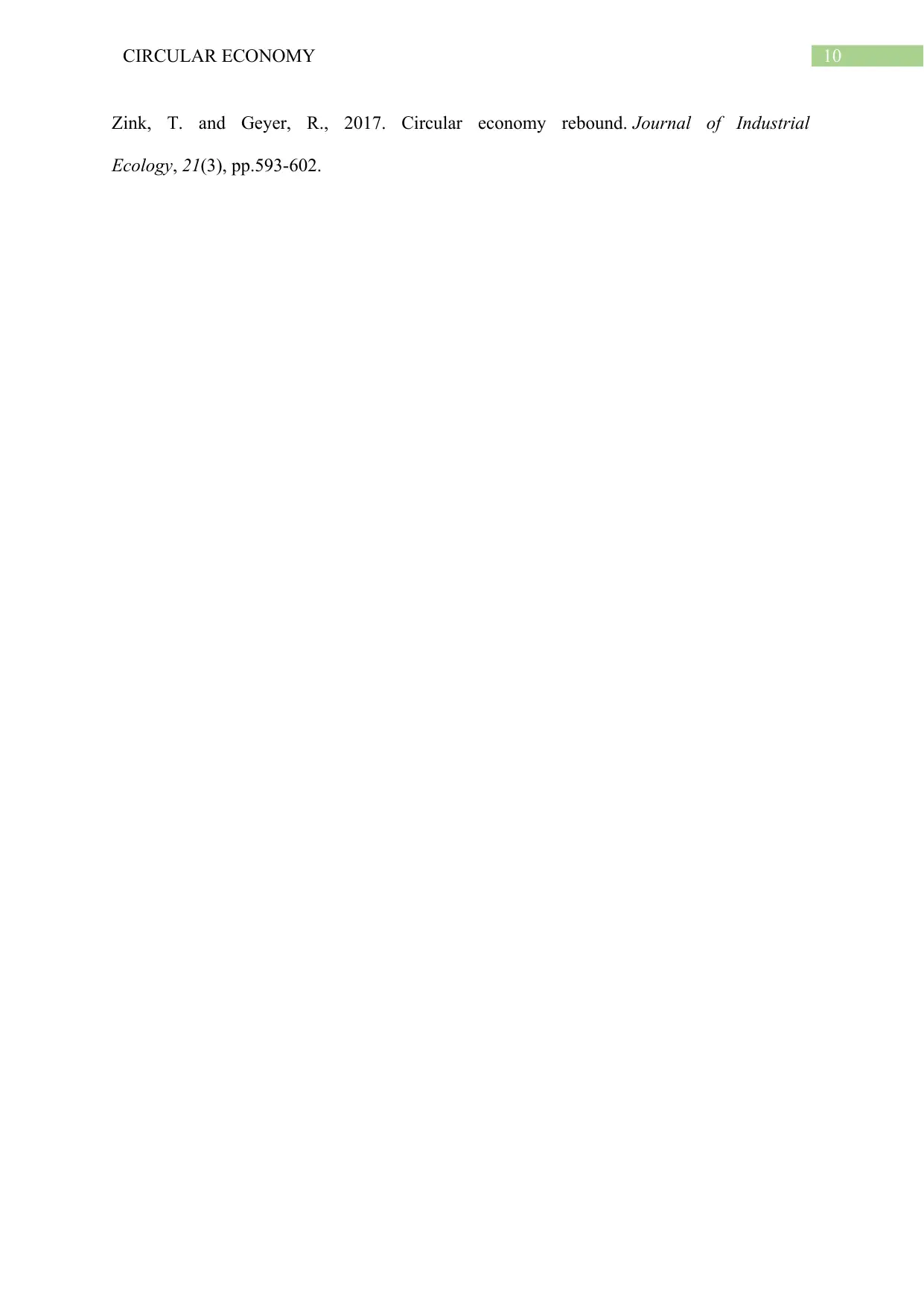
10CIRCULAR ECONOMY
Zink, T. and Geyer, R., 2017. Circular economy rebound. Journal of Industrial
Ecology, 21(3), pp.593-602.
Zink, T. and Geyer, R., 2017. Circular economy rebound. Journal of Industrial
Ecology, 21(3), pp.593-602.
1 out of 11
Related Documents
Your All-in-One AI-Powered Toolkit for Academic Success.
+13062052269
info@desklib.com
Available 24*7 on WhatsApp / Email
![[object Object]](/_next/static/media/star-bottom.7253800d.svg)
Unlock your academic potential
Copyright © 2020–2025 A2Z Services. All Rights Reserved. Developed and managed by ZUCOL.





